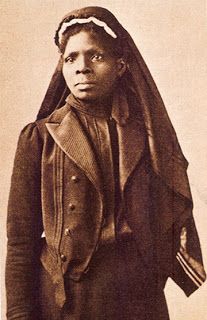The Civil Radical Battles of the Black American Soldier
Susie King Taylor

Susie King Taylor is known as the First African-American Army Nurse. Frontispiece of Reminiscences of My Life in Camp. Published, 1902. Library of Congress, General Collections.
Susie King Taylor, a teacher and nurse, achieved many firsts in a lifetime of overcoming adversity and helping elevate others out of slavery. As the author of Reminiscences of My Life in Camp with the 33d United States Colored Troops, Late 1st S.C. Volunteers, she was the only African American woman to publish a memoir of her wartime experiences.
Susie Baker was born into slavery near Savannah, Georgia in 1848. Despite Georgia’s harsh laws against the formal education of African Americans, she attended two secret schools taught by black women. Her literacy proved invaluable not only to her but to other African Americans she educated during the war. She became free at the age of 14 when her uncle led her out to a federal gunboat plying the waters near Confederate-held Fort Pulaski.
Baker and thousands of other African American refugees found themselves seeking safety behind Union lines on the South Carolina Sea Islands. She soon attached herself to the First South Carolina Volunteers, the first black regiment in the US Army. First organized by Major General David Hunter, the military governor Rufus Saxton would become the driving force behind the unit’s creation.
Taylor originally worked as the regimental laundress and throughout the war would perform the essential duties of cooking and washing. However, her literacy proved most useful and enabled her to serve as the reading instructor for the regiment of former slaves. The unit’s white abolitionist colonel, Thomas Wentworth Higginson, later wrote of his men, “Their love of the spelling book is perfectly inexhaustible.”
Taylor married Sergeant Edward King of the First South Carolina in 1862. Together they remained with the unit until it was mustered out of service in 1866. Postwar, the Kings moved to Savannah, Georgia. She hoped to continue her teaching career and opened a private school for the children of freedmen. Unfortunately, her husband died the same year, and a public school opening caused her private school to fail. By 1868, Taylor was forced to find work as a domestic servant.

She moved to Boston in 1872 where she married Russell Taylor in 1879. She devoted much of the rest of her life to working with the Woman’s Relief Corps, a national organization for female Civil War veterans. She died in 1912, ten years after publishing her memoir.
Honoring Black History: Celebrating the life of Civil War heroine, Susie King Taylor
“Susie King Taylor wrote her memories of being a Civil War nurse. Bringing her story up to date, she described an 1898 ladies’ fair in Massachusetts to raise money for the causes of the Grand Army of the Republic (the GAR), the Union veteran’s organization. Her contribution: “A large quilt of red, white, and blue ribbon that made quite a sensation.” Susie King Taylor Quilts were an important part of the fundraising and fellowship, especially in the women’s auxiliary groups such as the Women’s Relief Corps (WRC). Magazines published patterns with suggestions for making designs in red, white, and blue.”
